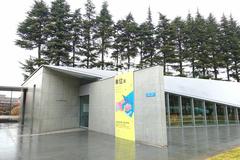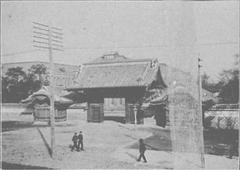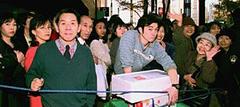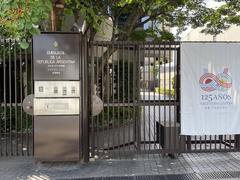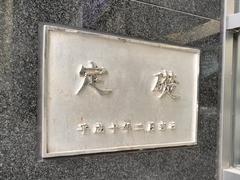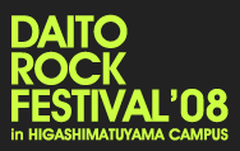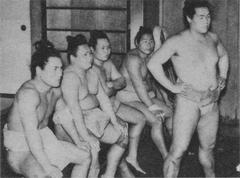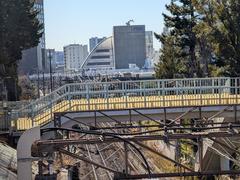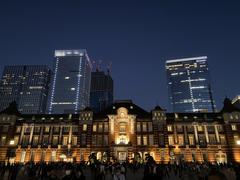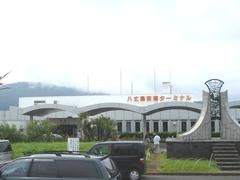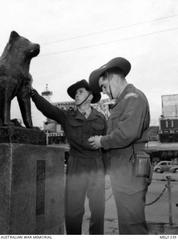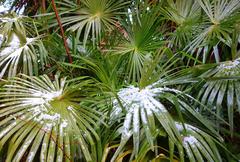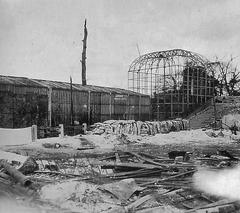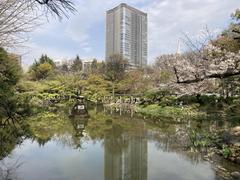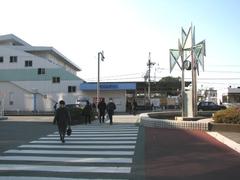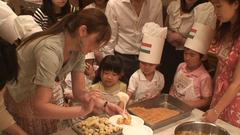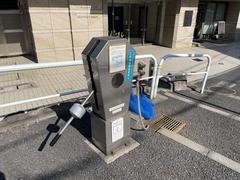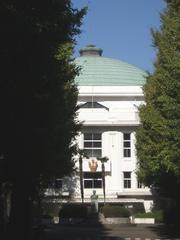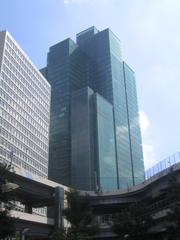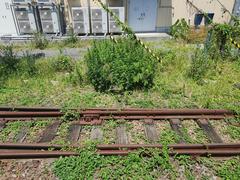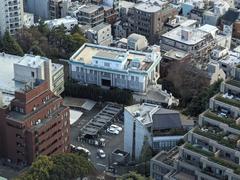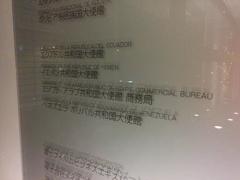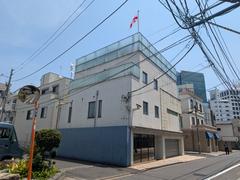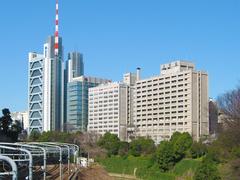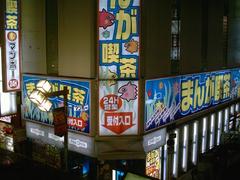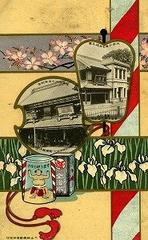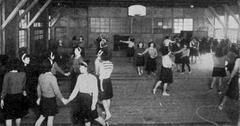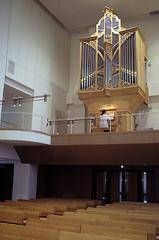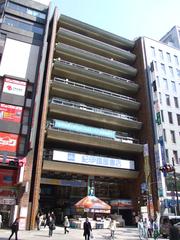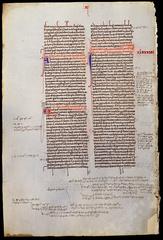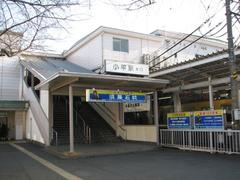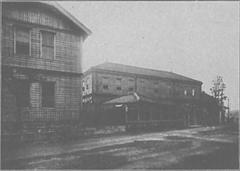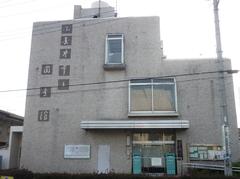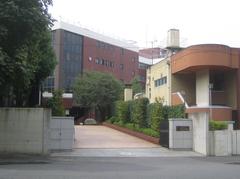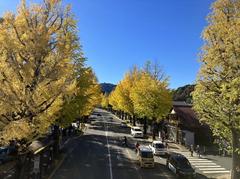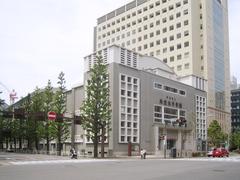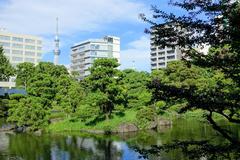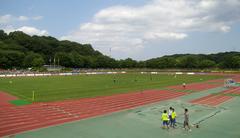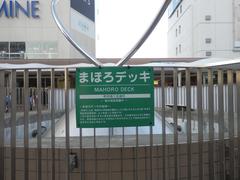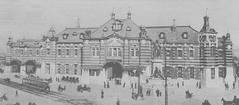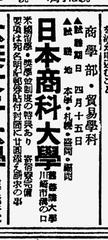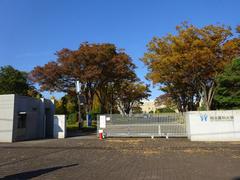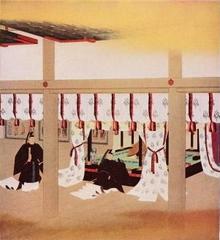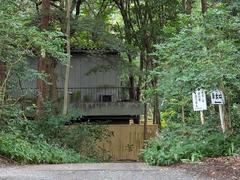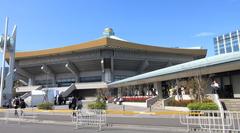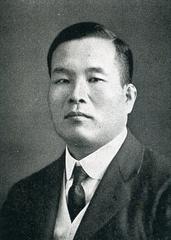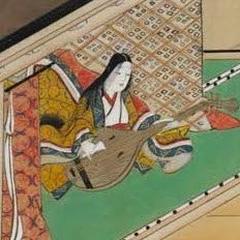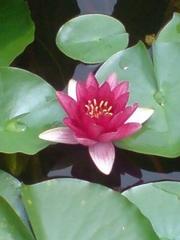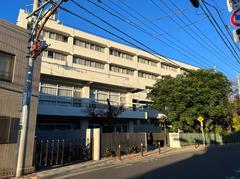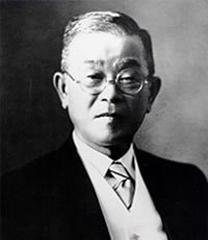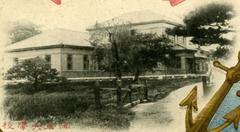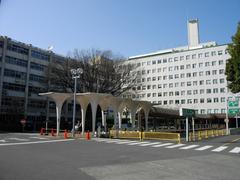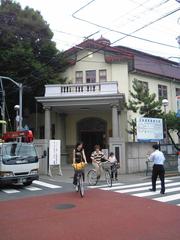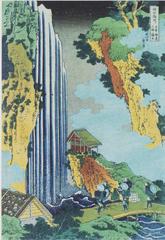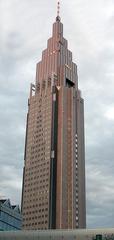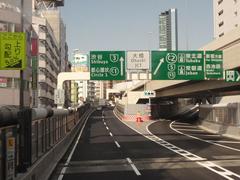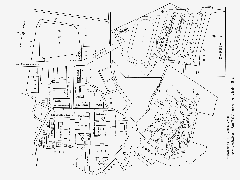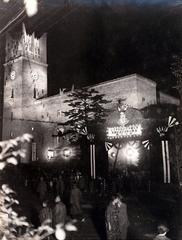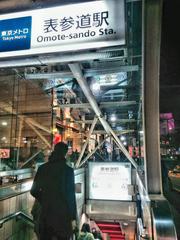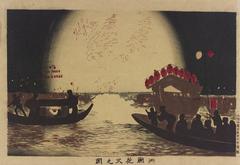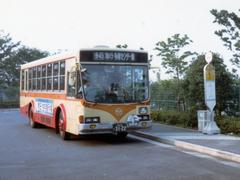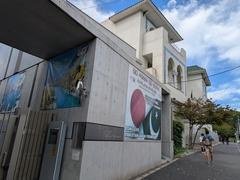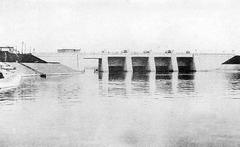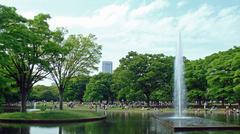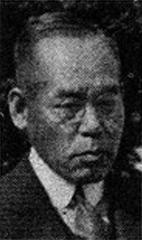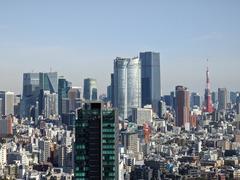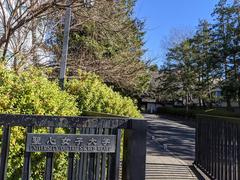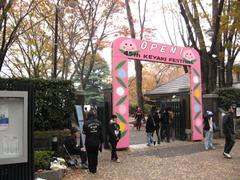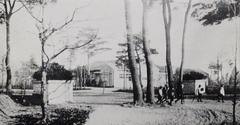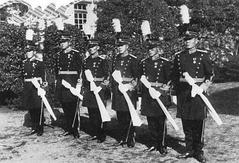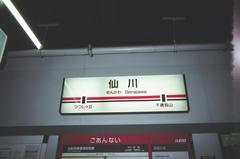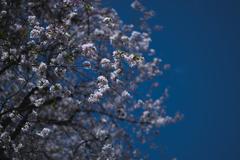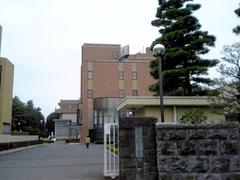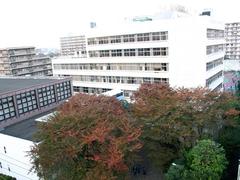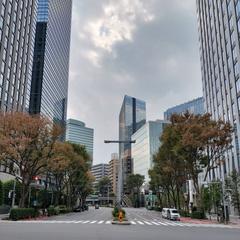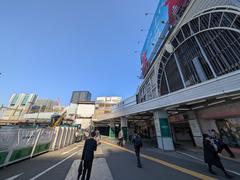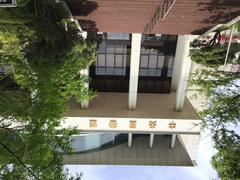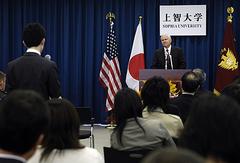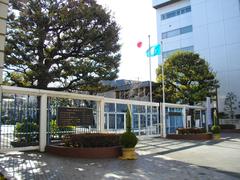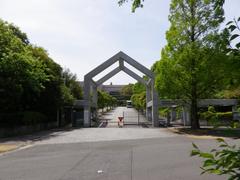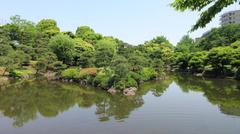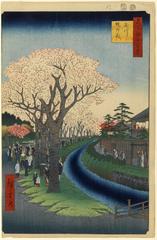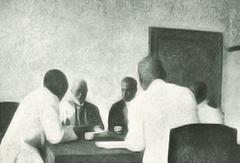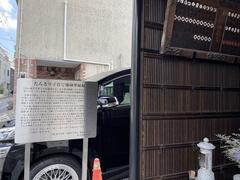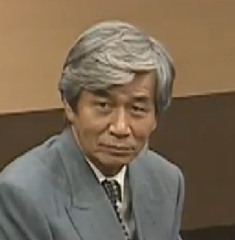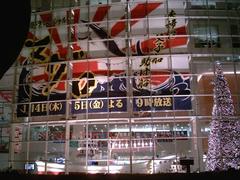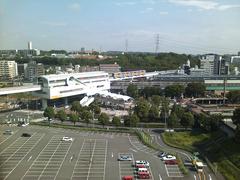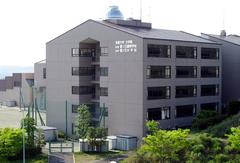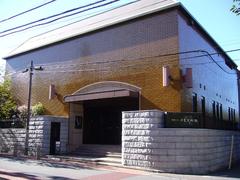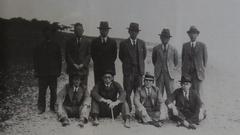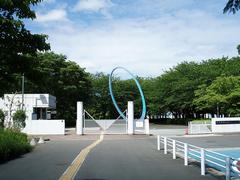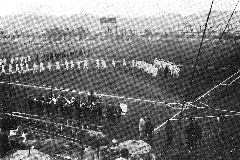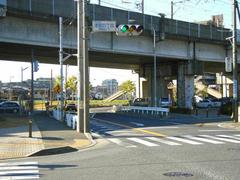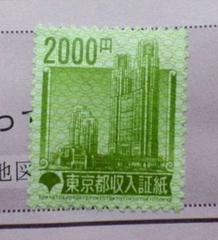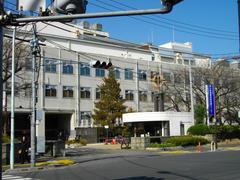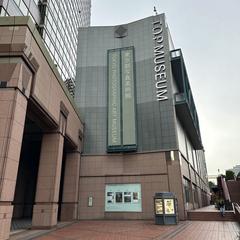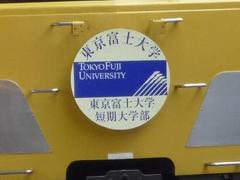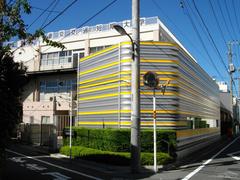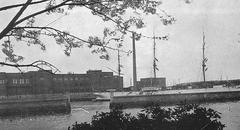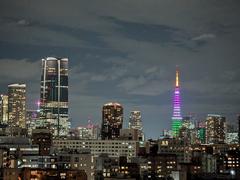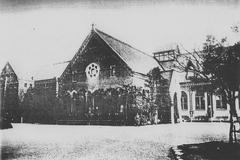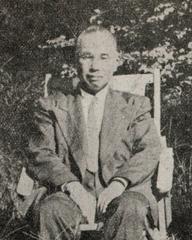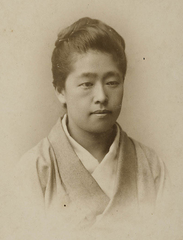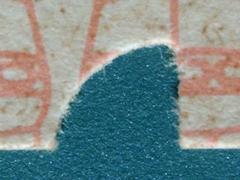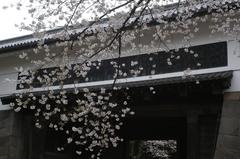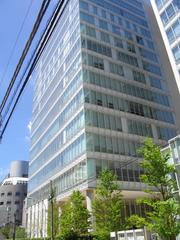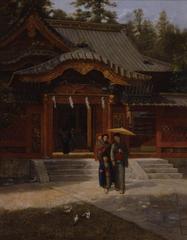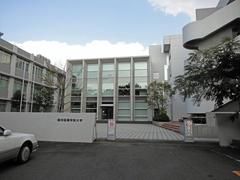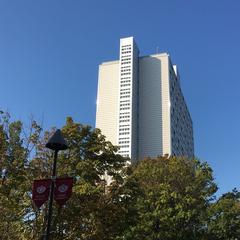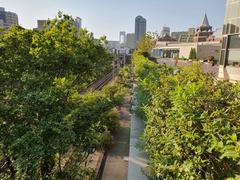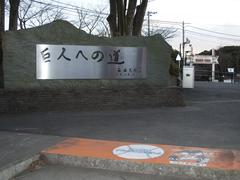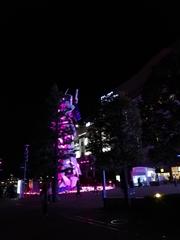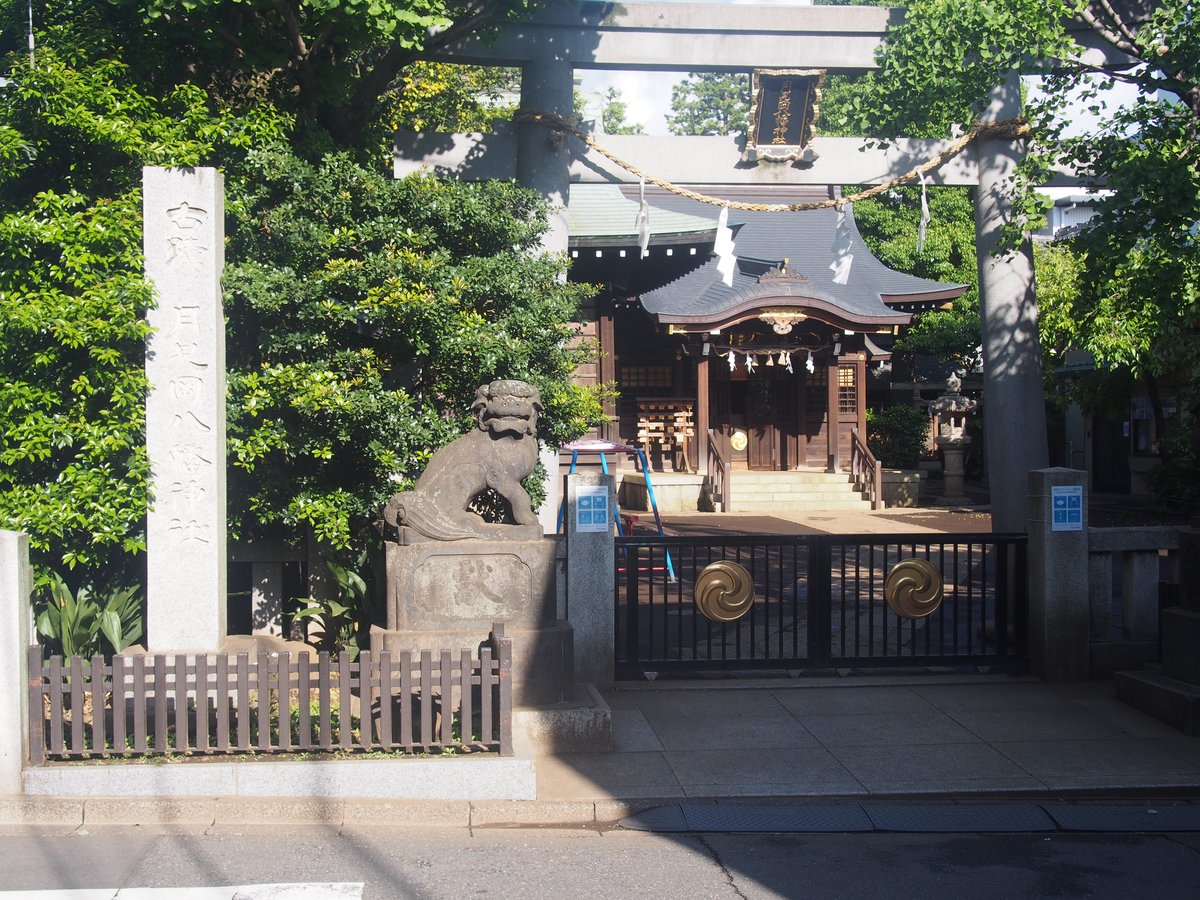
त्सुकिमिगाओका हाचिमन-जिंज: टोक्यो, जापान यात्रा के लिए व्यापक मार्गदर्शिका
दिनांक: 03/07/2025
परिचय
त्सुकिमिगाओका हाचिमन-जिंज टोक्यो की समृद्ध आध्यात्मिक और सांस्कृतिक विरासत का एक प्रमाण है। ओटा वार्ड में स्थित, यह ऐतिहासिक शिंटो तीर्थ, जिसकी स्थापना 860 ईस्वी में हुई थी, हाचिमन को समर्पित है—युद्ध के सम्मानित देवता और राष्ट्र के संरक्षक। आगंतुकों को सदियों पुरानी धार्मिक परंपराओं का पता लगाने का अवसर ही नहीं मिलता, बल्कि जीवंत उत्सवों, पारंपरिक अनुष्ठानों और लुभावनी वास्तुकला में भी डूबने का मौका मिलता है। तीर्थ तक पहुंचना आसान है, यह प्रतिदिन खुला रहता है और इसमें प्रवेश निःशुल्क है। यह अपनी स्वागत करने वाली भावना के लिए प्रसिद्ध है, जो इसे यात्रियों, परिवारों और संस्कृति के उत्साही लोगों के लिए एक पुरस्कृत गंतव्य बनाता है (Rodsshinto; Flip Japan Guide)।
यह व्यापक मार्गदर्शिका तीर्थ के दौरे के लिए आवश्यक जानकारी प्रदान करती है, जिसमें समय, टिकट, तीर्थ की वास्तुकला, प्रमुख उत्सव और व्यावहारिक यात्रा युक्तियाँ शामिल हैं। यह शहर में आपके सांस्कृतिक अनुभव को अधिकतम करने के लिए तीर्थ के टोक्यो के ऐतिहासिक स्थलों के व्यापक नेटवर्क से जुड़ाव पर भी प्रकाश डालती है।
सामग्री
- त्सुकिमिगाओका हाचिमन-जिंज का परिचय
- ऐतिहासिक पृष्ठभूमि और धार्मिक महत्व
- तीर्थ का लेआउट और वास्तुशिल्प विशेषताएँ
- उत्सव और सामुदायिक कार्यक्रम
- आगंतुक जानकारी: समय, टिकट और पहुंच
- आपकी यात्रा के लिए व्यावहारिक युक्तियाँ
- पहुंच मार्गदर्शिका
- अक्सर पूछे जाने वाले प्रश्न (FAQ)
- संबंधित लेख और संसाधन
- स्रोत
ऐतिहासिक पृष्ठभूमि और धार्मिक महत्व
उत्पत्ति और विरासत
त्सुकिमिगाओका हाचिमन-जिंज टोक्यो के प्रमुख हाचिमन तीर्थों में से एक है, जो शिंटो और बौद्ध प्रथाओं को आपस में जोड़ने वाली सदियों पुरानी परंपरा का हिस्सा है। हाचिमन की पूजा छठी से आठवीं शताब्दी के बीच शुरू हुई और 571 ईस्वी में आधिकारिक तौर पर मान्यता दी गई, जिसमें सम्राट किमेई ने उसिता, ओइता प्रान्त में सम्राट ओजिन का सम्मान किया (Rodsshinto)। समय के साथ, हाचिमन का प्रभाव गहरा होता गया, जो शाही परिवार और योद्धा (समुराई) वर्ग दोनों के संरक्षक देवता बन गए।
तीर्थ की वृद्धि जापानी इतिहास के महत्वपूर्ण क्षणों के समानांतर हुई—जैसे नारा काल में तोडाई-जी में विशाल बुद्ध का निर्माण और हेइयन और कामाकुरा काल में मिनामोटो वंश का उदय, जब हाचिमन को वंश के संरक्षक देवता के रूप में अपनाया गया (Hachiman Handscrolls)। ईदो काल तक, जापान में सभी शिंटो तीर्थों में से लगभग एक तिहाई हाचिमन तीर्थ थे।
प्रतिष्ठित देवता
त्सुकिमिगाओका हाचिमन-जिंज हाचिमन की समधर्मी विरासत को दर्शाता है, जो प्रतिष्ठित करता है:
- सम्राट ओजिन (応神天皇): हाचिमन के रूप में देवत्व प्राप्त।
- सम्राज्ञी जिंगू (神功皇后): ओजिन की माँ।
- हिमेगामी (比売神): एक महिला देवता जो अक्सर तीर्थ से जुड़ी होती है (Rodsshinto)।
कबूतर (शांति) और धनुष/तीर (मार्शल सुरक्षा) जैसे प्रतीक पूरे मैदान में प्रचलित हैं (Uniproyecta)।
तीर्थ का लेआउट और वास्तुशिल्प विशेषताएँ
मुख्य विशेषताएँ
- तोरी गेट: प्रवेश एक आकर्षक लाल तोरी द्वारा चिह्नित है, जो पवित्र सीमा का संकेत देता है (Flip Japan Guide)।
- हाइडन (पूजा हॉल) और होंडेन (मुख्य अभयारण्य): केंद्रीय संरचनाएँ, पारंपरिक नगार-ज़ुकुरी शैली में निर्मित, प्रतिष्ठित देवताओं का निवास करती हैं (japan-shrine.info)।
- तेमिज़ुया (शुद्धिकरण बेसिन): आगंतुक प्रार्थना से पहले खुद को यहाँ शुद्ध करते हैं।
- पवित्र वृक्ष: परिपक्व जिन्कगो और कपूर के पेड़, अक्सर शिमेनावा (पवित्र रस्सी) में लिपटे होते हैं, प्रकृति के प्रति शिंटो श्रद्धा को दर्शाते हैं।
- सहायक तीर्थ: परिसर के भीतर छोटे उप-तीर्थ संबंधित कामी और ऐतिहासिक हस्तियों का सम्मान करते हैं।
अद्वितीय तत्व
- फ़ूजी टीला (Fujizuka): माउंट फ़ूजी की नकल करने वाला एक कृत्रिम पहाड़ी, जिसे एक मूर्त लोक सांस्कृतिक संपत्ति नामित किया गया है (japan-shrine.info)।
- शोगी हॉल: जापानी खेल शोगी से तीर्थ के संबंध को मनाने वाला एक विशेष हॉल।
- कोगो इनारी तीर्थ: कगो वंश के योद्धाओं को समर्पित एक चमकीले ढंग से चित्रित उप-तीर्थ।
- अनुष्ठान स्थान: नए साल के समारोहों के दौरान शुद्धिकरण के लिए चिनोवा (कोन घास की अंगूठी) जैसी मौसमी सजावट स्थापित की जाती है।
अनुष्ठान प्रथाएँ
आगंतुकों को जल शुद्धिकरण में भाग लेने, प्रसाद चढ़ाने, सुरक्षात्मक ताबीज (ओमामोरी) खरीदने और भाग्य पर्ची (ओमिकुजी) निकालने के लिए प्रोत्साहित किया जाता है। अनुष्ठान पारंपरिक शिष्टाचार का पालन करते हैं: तोरी पर झुकना, तेमिज़ुया पर शुद्धिकरण करना और मुख्य हॉल में प्रार्थना करना (Flip Japan Guide)।
उत्सव और सामुदायिक कार्यक्रम
वार्षिक उत्सव (रेइताईसाई)
रेइताईसाई, जो 7 सितंबर के आसपास आयोजित होता है, तीर्थ का मुख्य उत्सव है। इसमें शामिल हैं:
- पुजारियों द्वारा नेतृत्व किए जाने वाले शिंटो अनुष्ठान
- मिकॉशी (पोर्टेबल तीर्थ) का जुलूस
- कागुरा संगीत और नृत्य
- खाद्य स्टॉल और बच्चों के खेल
यह उत्सव स्थानीय समुदाय के लिए एक आकर्षण है, जो टोक्यो भर से आगंतुकों को आकर्षित करता है (Rodsshinto)।
अन्य मौसमी कार्यक्रम
- हात्सुमोडे (नव वर्ष): अच्छी किस्मत के लिए प्रार्थना करने वाले भक्तों से तीर्थ भीड़भाड़ वाला होता है (Japan Switch)।
- शिचि-गो-सन (15 नवंबर): बच्चों के लिए एक संस्कार।
- हानामी (वसंत): सेन्ज़ोकु झील के पास चेरी ब्लॉसम देखना (Rodsshinto)।
सामुदायिक भागीदारी
पड़ोस संघ और स्वयंसेवक कार्यक्रमों के आयोजन, मैदान के रखरखाव और उत्सवों के दौरान मिकॉशी ले जाने में प्रमुख भूमिका निभाते हैं। तीर्थ स्थानीय पहचान और परंपरा की एक मजबूत भावना को बढ़ावा देता है।
आगंतुक जानकारी: समय, टिकट और पहुंच
यात्रा का समय
- प्रतिदिन खुला: सुबह 6:00 बजे - शाम 5:00 बजे (कुछ स्रोत 9:00 बजे - शाम 5:00 बजे सूचीबद्ध करते हैं; मौसमी बदलावों या कार्यक्रम दिनों के लिए पहले से जांच लें)
प्रवेश
- निःशुल्क प्रवेश सभी आगंतुकों के लिए। दान का स्वागत है, विशेषकर उत्सवों के दौरान।
दिशा-निर्देश
- स्थान: सेन्ज़ोकुइके स्टेशन (तोक्यु इकेगामी लाइन) से लगभग 650 मीटर, स्पष्ट साइनेज और आसान पैदल पहुंच के साथ (Rodsshinto)।
- आस-पास के स्थल: अपनी यात्रा को टोक्यो के अन्य स्थलों जैसे तोमिओका हाचिमानगु, ओमिया हाचिमान-गु और किताज़ावा हाचिमन जिंजा के साथ संयोजित करें।
पहुंच
- शारीरिक पहुंच: मैदान ज्यादातर समतल और पक्के हैं, लेकिन कुछ सहायक क्षेत्रों में सीढ़ियाँ या बजरी हो सकती है। व्हीलचेयर उपयोगकर्ताओं को सहायता की आवश्यकता हो सकती है।
- सार्वजनिक परिवहन: तीर्थ टोक्यो के ट्रेन और बस नेटवर्क के माध्यम से अच्छी तरह से जुड़ा हुआ है।
- सुविधाएं: साइट पर सुलभ शौचालय उपलब्ध नहीं हो सकते हैं, लेकिन उन्हें आस-पास के स्टेशनों पर पाया जा सकता है।
आपकी यात्रा के लिए व्यावहारिक युक्तियाँ
- सर्वोत्तम समय: शांति के लिए सुबह जल्दी या देर दोपहर। जीवंत उत्सवों के लिए उत्सवों के दौरान जाएँ, लेकिन भीड़ की अपेक्षा करें।
- क्या लाएँ: आरामदायक जूते, प्रसाद या ताबीज खरीदने के लिए नकद, और मौसम के उपयुक्त कपड़े।
- शिष्टाचार: तोरी पर झुकें, अनुष्ठानों में सम्मानपूर्वक भाग लें, और पवित्र स्थानों में मौन का पालन करें।
- फोटोग्राफी: तीर्थ के मैदान में अनुमति है, लेकिन मुख्य हॉल के अंदर या समारोहों के दौरान तस्वीरें लेने से बचें।
- परिवार के अनुकूल: खुले स्थान बच्चों के लिए उपयुक्त हैं, हालांकि बजरी पर स्ट्रॉलर का उपयोग करना मुश्किल हो सकता है।
- सेवा पशु: आम तौर पर अनुमत; आगमन पर कर्मचारियों को सूचित करें।
- भाषा: बुनियादी अंग्रेजी साइनेज उपलब्ध है। कर्मचारी सीमित अंग्रेजी बोल सकते हैं, लेकिन संचार आमतौर पर संभव है।
पहुंच मार्गदर्शिका
- व्हीलचेयर पहुंच: कुछ रैंप और समतल रास्ते मौजूद हैं, लेकिन कुछ पारंपरिक विशेषताएँ कम सुलभ हो सकती हैं (Accessible Japan)। यदि आपकी विशिष्ट आवश्यकताएं हैं तो पहले से तीर्थ से संपर्क करें।
- परिवहन: अधिकांश आस-पास के स्टेशनों में लिफ्ट और सुलभ शौचालय हैं। एक आसान यात्रा के लिए चरम समय से बचें (Go Tokyo)।
- दृश्य/श्रवण आवश्यकताएँ: स्पर्शनीय फ़र्श और बहुभाषी साइनेज अधिक सामान्य होते जा रहे हैं।
अक्सर पूछे जाने वाले प्रश्न (FAQ)
Q: आधिकारिक यात्रा का समय क्या है? A: प्रतिदिन सुबह 6:00 बजे - शाम 5:00 बजे; विशेष कार्यक्रमों के लिए पहले से जांच लें।
Q: क्या प्रवेश शुल्क है? A: प्रवेश निःशुल्क है; दान को प्रोत्साहित किया जाता है।
Q: क्या निर्देशित पर्यटन उपलब्ध हैं? A: कभी-कभी उपलब्ध; तीर्थ या स्थानीय आगंतुक केंद्रों से जांचें।
Q: क्या तीर्थ व्हीलचेयर उपयोगकर्ताओं के लिए सुलभ है? A: अधिकांश क्षेत्र सुलभ हैं, लेकिन कुछ सीढ़ियाँ या बजरी वाले रास्ते चुनौतियाँ पेश कर सकते हैं।
Q: क्या मैं तस्वीरें ले सकता हूँ? A: हाँ, मैदान में। मुख्य हॉल के अंदर या अनुष्ठानों के दौरान तस्वीरें लेने से बचें।
Q: अन्य आस-पास के आकर्षण क्या हैं? A: शिबुया, हाराजुकु, शिंजुकु, और अन्य सांस्कृतिक स्थल आसानी से सुलभ हैं।
संबंधित लेख और संसाधन
अपनी यात्रा की योजना बनाएं और जुड़े रहें
ऑडियल जैसी ऐप्स का उपयोग करके अपनी यात्रा को बेहतर बनाएं, जिसमें ऑडियो गाइड, कार्यक्रम सूचनाएं और इंटरैक्टिव मानचित्र हों। तीर्थ के आधिकारिक चैनलों को फॉलो करके और नवीनतम उत्सव की जानकारी के लिए गाइड की जाँच करके अद्यतित रहें।
सारांश और आगंतुक युक्तियाँ
त्सुकिमिगाओका हाचिमन-जिंज केवल एक तीर्थ से कहीं अधिक है—यह टोक्यो की आध्यात्मिक, ऐतिहासिक और सामुदायिक धागों को एक साथ लाने वाला एक जीवंत सांस्कृतिक प्रतीक है। इसके खुले मैदान, ऐतिहासिक वास्तुकला और समावेशी परंपराएं इसे जापान की विरासत में रुचि रखने वाले किसी भी व्यक्ति के लिए एक आवश्यक स्थल बनाती हैं। डिजिटल संसाधनों का लाभ उठाएं, प्रमुख उत्सवों के दौरान अपनी यात्रा की योजना बनाएं, और शांति और उत्सव के अद्वितीय मिश्रण को अपनाएं जो इस उल्लेखनीय तीर्थ को परिभाषित करता है (Rodsshinto; Flip Japan Guide)।
स्रोत
- त्सुकिमिगाओका हाचिमन-जिंज की खोज: इतिहास, यात्रा समय और टोक्यो की आध्यात्मिक विरासत, 2025, रोड्सशिंटो (https://www.rodsshinto.com/hachiman)
- त्सुकिमिगाओका हाचिमन-जिंज की खोज: एक ऐतिहासिक टोक्यो तीर्थ में उत्सव, यात्रा समय और सामुदायिक परंपराएं, 2025, रोड्सशिंटो (https://www.rodsshinto.com/13-111-03)
- त्सुकिमिगाओका हाचिमन-जिंज यात्रा समय, टिकट और टोक्यो ऐतिहासिक स्थल मार्गदर्शिका, 2025, फ्लिप जापान गाइड (https://flipjapanguide.com/japanese-shrines-a-foreigners-guide/)
- हातोमोरी हाचिमन तीर्थ की यात्रा: टोक्यो में समय, टिकट, इतिहास और वास्तुशिल्प मुख्य बातें, 2025, japan-shrine.info (https://japan-shrine.info/en/hatomori-hachiman-shrine/)
- त्सुकिमिगाओका हाचिमन-जिंज की खोज: एक ऐतिहासिक टोक्यो तीर्थ में उत्सव, यात्रा समय और सामुदायिक परंपराएं, 2025, जापान स्विच (https://japanswitch.com/ultimate-guide-to-visiting-shrines-in-tokyo/)
- त्सुकिमिगाओका हाचिमन-जिंज की खोज: एक ऐतिहासिक टोक्यो तीर्थ में उत्सव, यात्रा समय और सामुदायिक परंपराएं, 2025, ट्रैवल टाउन जेपी (https://www.traveltowns.jp/en/matsuri/tokyo/)
ऑडियल2024# Comprehensive Guide to Visiting Tsukimigaoka Hachiman-Jinja, Tokyo, Japan: Visiting Hours, Tickets, and Tokyo Historical Sites Guide
Date: 03/07/2025
Introduction
Tsukimigaoka Hachiman-Jinja is a captivating historic Shinto shrine nestled in Tokyo’s Ōta Ward, representing a rich confluence of Japan’s spiritual heritage, cultural traditions, and community life. Established as early as 860 CE, this shrine is dedicated to Hachiman, the revered god of war and protector of the nation, whose worship has deeply influenced Japan’s imperial history and samurai culture (Rodsshinto). Visitors to Tsukimigaoka Hachiman-Jinja gain not only a glimpse into centuries of religious devotion but also an immersive experience of vibrant festivals, traditional rituals, and architectural elegance.
Offering daily access from 6:00 AM to 5:00 PM with free admission, the shrine welcomes all visitors to explore its tranquil grounds marked by iconic red torii gates, sacred purification basins, and serene worship halls (Flip Japan Guide). The site harmoniously blends Shinto and Buddhist elements, reflecting Hachiman’s syncretic heritage, and enshrines key deities such as Emperor Ōjin and Empress Jingū. Its proximity to other notable Tokyo historical sites makes it an excellent cultural stop for travelers eager to delve into Japan’s spiritual landscape.
The shrine’s calendar is punctuated by lively community events like the Reitaisai festival in early September and traditional New Year’s celebrations (hatsumode), which showcase processions, sacred music, and local volunteerism, inviting visitors to participate respectfully and enjoy authentic Japanese matsuri culture (Rodsshinto; Japan Switch). Moreover, Tsukimigaoka Hachiman-Jinja prioritizes accessibility with mostly paved paths and useful visitor information, ensuring a welcoming environment for families, individuals with mobility needs, and cultural enthusiasts alike.
Whether you are keen on historical exploration, spiritual reflection, or festive celebration, this comprehensive guide will equip you with vital information on visiting hours, ticketing, shrine architecture, community traditions, and travel tips, helping you maximize your experience at one of Tokyo’s treasured spiritual landmarks (Travel Towns JP; Flip Japan Guide). For more immersive exploration, consider utilizing virtual tours, interactive maps, and mobile apps like Audiala, which provide personalized cultural insights and updates on shrine events.
Contents
- Introduction to Tsukimigaoka Hachiman-Jinja
- Historical Background and Religious Significance
- Shrine Layout and Architectural Features
- Festivals and Community Events
- Visitor Information: Hours, Tickets, and Accessibility
- Practical Tips for Your Visit
- Accessibility Guide
- Frequently Asked Questions (FAQ)
- Related Articles and Resources
- Sources
Historical Background and Religious Significance
Origins and Legacy
Tsukimigaoka Hachiman-Jinja is one of Tokyo’s prominent Hachiman shrines, forming part of a centuries-old tradition that intertwines Shinto and Buddhist practices. Hachiman’s worship began between the 6th and 8th centuries and was officially recognized in 571 CE, with Emperor Kinmei’s veneration of Emperor Ōjin in Usa, Oita Prefecture (Rodsshinto). Over time, Hachiman’s influence deepened, becoming the guardian deity of both the imperial family and the warrior (samurai) class.
The shrine’s growth paralleled critical moments in Japanese history—such as the construction of the Great Buddha at Tōdai-ji in the Nara period and the rise of the Minamoto clan in the Heian and Kamakura periods, when Hachiman was adopted as the clan’s patron deity (Hachiman Handscrolls). By the Edo period, Hachiman shrines accounted for about one-third of all Shinto shrines in Japan.
Enshrined Deities
Tsukimigaoka Hachiman-Jinja reflects Hachiman’s syncretic heritage, enshrining:
- Emperor Ōjin (応神天皇): Deified as Hachiman.
- Empress Jingū (神功皇后): Mother of Ōjin.
- Himegami (比売神): A female deity often associated with the shrine (Rodsshinto).
Symbols such as doves (peace) and bows/arrows (martial protection) are prevalent throughout the grounds (Uniproyecta).
Shrine Layout and Architectural Features
Main Features
- Torii Gates: The entrance is marked by a striking red torii, signifying the sacred boundary (Flip Japan Guide).
- Haiden (Worship Hall) and Honden (Main Sanctuary): The central structures, built in traditional nagare-zukuri style, house the enshrined deities (japan-shrine.info).
- Temizuya (Purification Basin): Visitors purify themselves here before prayer.
- Sacred Trees: Mature ginkgo and camphor trees, often wrapped in shimenawa (sacred rope), reflect Shinto reverence for nature.
- Auxiliary Shrines: Smaller sub-shrines within the precinct honor related kami and historical figures.
Unique Elements
- Fuji Mound (Fujizuka): An artificial hill replicating Mount Fuji, designated as a Tangible Folk Cultural Property (japan-shrine.info).
- Shogi Hall: A special hall commemorating the shrine’s connection to the Japanese game shogi.
- Koga Inari Shrine: A brightly painted sub-shrine dedicated to the warriors of the Koga clan.
- Ritual Spaces: Seasonal decorations like the chinowa (cogon grass ring) are set up for purification during New Year’s ceremonies.
Ritual Practices
Visitors are encouraged to participate in water purification, make offerings, purchase protective amulets (omamori), and draw fortune slips (omikuji). Rituals follow traditional etiquette: bowing at the torii, purifying at the temizuya, and offering prayers at the main hall (Flip Japan Guide).
Festivals and Community Events
Annual Festival (Reitaisai)
The Reitaisai, held around September 7, is the shrine’s principal festival. It features:
- Shinto rituals led by priests
- Mikoshi (portable shrine) processions
- Kagura music and dance
- Food stalls and children’s games
This festival is a highlight for the local community, drawing visitors from across Tokyo (Rodsshinto).
Other Seasonal Events
- Hatsumode (New Year’s): The shrine is crowded with worshippers praying for good fortune (Japan Switch).
- Shichi-Go-San (November 15): A rite of passage for children.
- Hanami (Spring): Cherry blossom viewing near Lake Senzoku (Rodsshinto).
Community Involvement
Neighborhood associations and volunteers play key roles in organizing events, maintaining the grounds, and carrying the mikoshi during festivals. The shrine fosters a strong sense of local identity and tradition.
Visitor Information: Hours, Tickets, and Accessibility
Visiting Hours
- Open daily: 6:00 AM – 5:00 PM (some sources list 9:00 AM – 5:00 PM; check ahead for seasonal variations or event days)
Admission
- Free entry to all visitors. Donations are welcomed, especially during festivals.
Directions
- Location: Approximately 650 meters from Senzokuike Station (Tokyu Ikegami Line), with clear signage and easy walking access (Rodsshinto).
- Nearby Sites: Combine your visit with other Tokyo landmarks such as Tomioka Hachimangu, Ōmiya Hachiman-Gū, and Kitazawa Hachiman Jinja.
Accessibility
- Physical Access: Grounds are mostly flat and paved, but some auxiliary areas may have steps or gravel. Wheelchair users may require assistance.
- Public Transport: The shrine is well-connected via Tokyo’s train and bus network.
- Facilities: Accessible restrooms may not be available on-site, but can be found at nearby stations.
Practical Tips for Your Visit
- Best Times: Early morning or late afternoon for tranquility. Visit during festivals for lively celebrations, but expect crowds.
- What to Bring: Comfortable shoes, cash for offerings or purchasing amulets, and weather-appropriate clothing.
- Etiquette: Bow at the torii, participate respectfully in rituals, and observe silence in sacred spaces.
- Photography: Allowed on shrine grounds, but avoid taking photos inside the main hall or during ceremonies.
- Family-Friendly: Open spaces are suitable for children, though strollers may be difficult to use on gravel.
- Service Animals: Generally permitted; inform staff upon arrival.
- Language: Basic English signage is available. Staff may speak limited English, but communication is usually manageable.
Accessibility Guide
- Wheelchair Access: Some ramps and flat paths are present, but certain traditional features may be less accessible (Accessible Japan). Contact the shrine in advance if you have specific needs.
- Transport: Most nearby stations have elevators and accessible toilets. Avoid peak hours for a smoother journey (Go Tokyo).
- Visual/Auditory Needs: Tactile paving and multilingual signage are becoming more common.
Frequently Asked Questions (FAQ)
Q: What are the official visiting hours? A: 6:00 AM – 5:00 PM daily; check ahead for special events.
Q: Is there an admission fee? A: Entry is free; donations are encouraged.
Q: Are there guided tours? A: Occasionally available; check with the shrine or local visitor centers.
Q: Is the shrine accessible for wheelchair users? A: Most areas are accessible, but some steps or gravel paths may present challenges.
Q: Can I take photos? A: Yes, in the grounds. Avoid photographing inside the main hall or during rituals.
Q: What are other nearby attractions? A: Shibuya, Harajuku, Shinjuku, and other cultural landmarks are easily accessible.
Related Articles and Resources
Plan Your Visit and Stay Connected
Enhance your experience by using apps like Audiala for audio guides, event notifications, and interactive maps. Stay updated by following the shrine’s official channels and checking guides for the latest festival information.
Summary and Visitor Tips
Tsukimigaoka Hachiman-Jinja is more than just a shrine—it is a living cultural landmark that brings together the spiritual, historical, and communal threads of Tokyo. Its open grounds, historic architecture, and inclusive traditions make it an essential site for anyone interested in Japan’s heritage. Leverage digital resources, plan your visit during major festivals, and embrace the unique blend of tranquility and celebration that defines this remarkable shrine (Rodsshinto; Flip Japan Guide).
Sources
- Exploring Tsukimigaoka Hachiman-Jinja: History, Visiting Hours, and Tokyo’s Spiritual Heritage, 2025, Rodsshinto (https://www.rodsshinto.com/hachiman)
- Exploring Tsukimigaoka Hachiman-Jinja: Festivals, Visiting Hours, and Community Traditions at a Historic Tokyo Shrine, 2025, Rodsshinto (https://www.rodsshinto.com/13-111-03)
- Tsukimigaoka Hachiman-Jinja Visiting Hours, Tickets, and Tokyo Historical Sites Guide, 2025, Flip Japan Guide (https://flipjapanguide.com/japanese-shrines-a-foreigners-guide/)
- Visiting Hatomori Hachiman Shrine: Hours, Tickets, History, and Architectural Highlights in Tokyo, 2025, japan-shrine.info (https://japan-shrine.info/en/hatomori-hachiman-shrine/)
- Exploring Tsukimigaoka Hachiman-Jinja: Festivals, Visiting Hours, and Community Traditions at a Historic Tokyo Shrine, 2025, Japan Switch (https://japanswitch.com/ultimate-guide-to-visiting-shrines-in-tokyo/)
- Exploring Tsukimigaoka Hachiman-Jinja: Festivals, Visiting Hours, and Community Traditions at a Historic Tokyo Shrine, 2025, Travel Towns JP (https://www.traveltowns.jp/en/matsuri/tokyo/)

